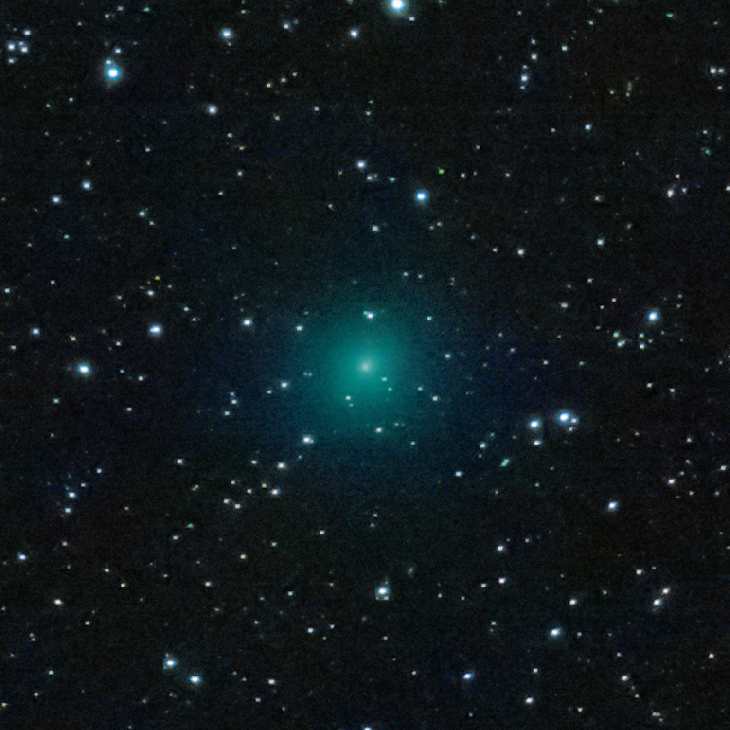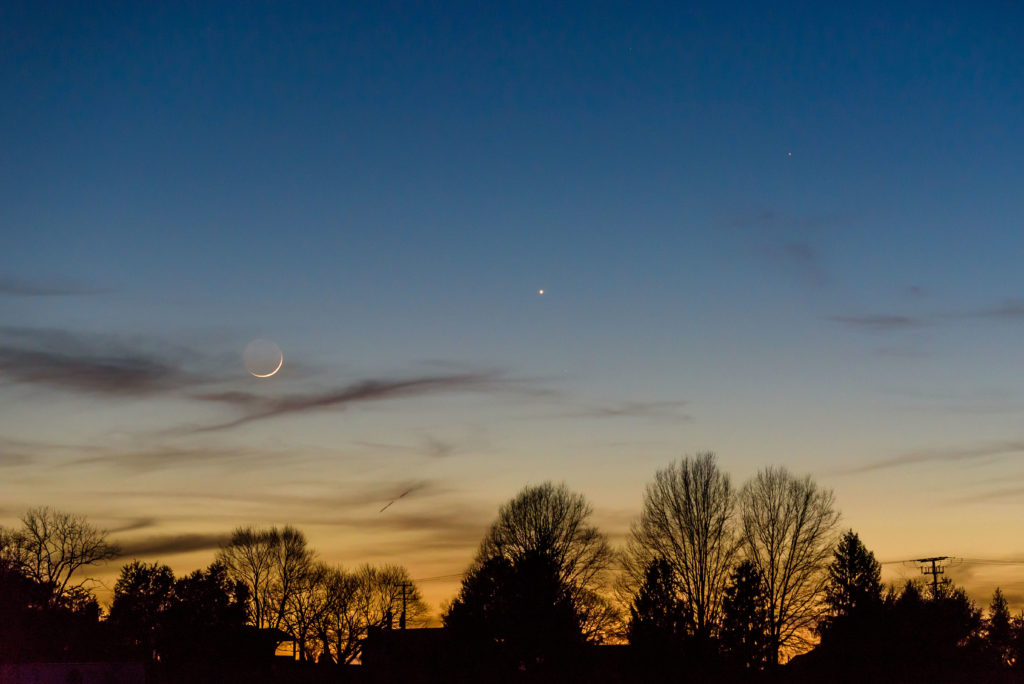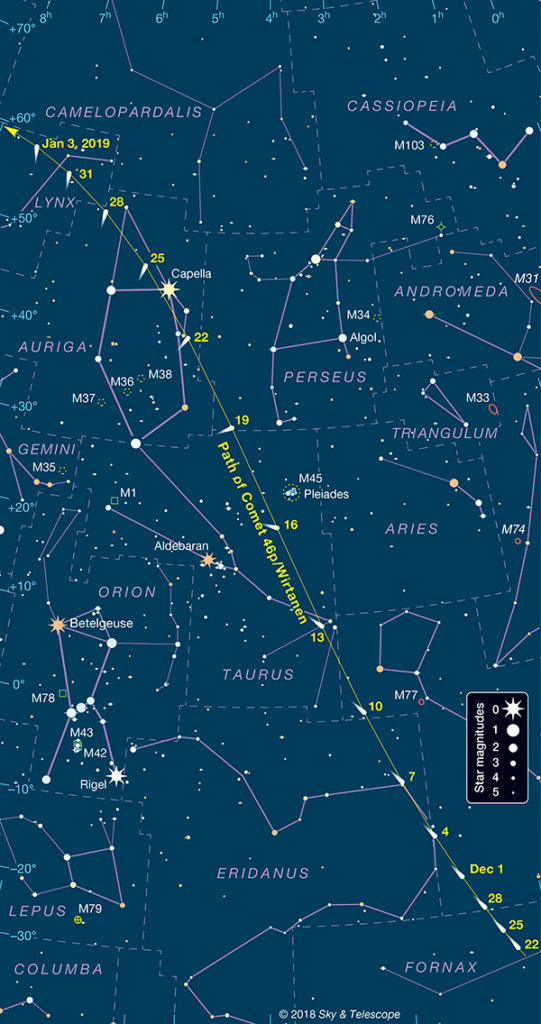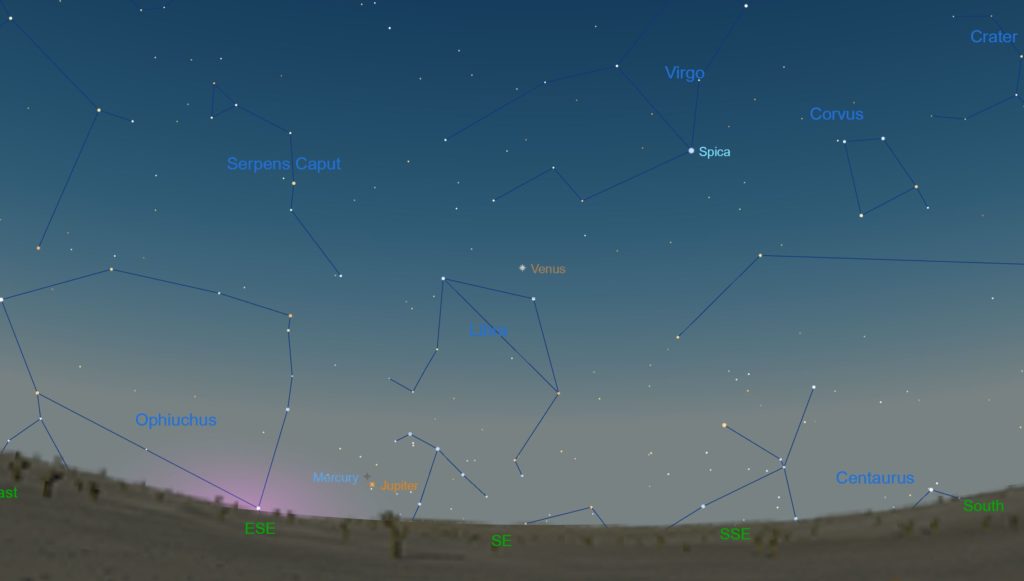
As the year 2018 comes to an end, the sky is full of wonders and celestial sights to behold. Planets congregate in the morning sky, with Venus reaching an astonishing degree of brightness, while Jupiter and Venus make a close approach on the day of December solstice. The Geminids, a reliable and impressive meteor shower, peaks at mid month. And a small periodic comet makes a close approach to Earth, possibly growing bright and large enough to see without optics and making a photogenic target for imagers. Here’s what to see in the night sky this month…
1-2 December. The planet Venus, prominent in the southeastern sky before sunrise, reaches its greatest illuminated extent. The planet shines at an amazingly bright magnitude -4.9, as bright as it ever gets. Spot the planet before sunrise, then see if you can track it through the morning sky into full daylight.
2-3 Dec. Venus, Spica, and the waning crescent Moon form a tight triangle in the southeastern sky before sunrise.
5 Dec. The planet Mercury is about 2º south of a very slender crescent Moon in the morning sky before dawn. Mercury makes a good show of it this month, moving about 21º west of the Sun by mid-month, well above the eastern horizon, and reaching a respectable magnitude of -0.5. Jupiter joins the planet all month, and both planets nearly brush past each other on Dec. 21.

7 Dec. New Moon, 7:20 UT
7 Dec. Mars and Neptune are remarkably close together, as close as just 2’ (arc-minutes) as seen in some parts of the world. Look for these two planets in the constellation Pisces in the southeast to southern sky after sunset and throughout the night. Telescope required to see both planets together.
9 Dec. Saturn is about 1º south of a wafer-thin waxing crescent Moon in the southwestern evening sky after sunset. The planet moves towards the Sun each night on its way to conjunction on Jan. 2, 2019.
13-14 Dec. Enjoy the Geminid meteor shower in the late hours of December 13 and into the morning of the 14th. One of the best and most reliable meteor showers, the Geminids are somewhat favored this year by a waxing crescent Moon which keeps the sky relatively dark after midnight. You can see Geminid meteors anywhere in the sky and from anywhere on Earth. They trace their path back to a point in the constellation Gemini near the star Castor. If possible, look just after dark for a few Geminids as they enter the atmosphere at a shallow angle and burn slowly across the sky. The meteor shower happens on this date each year as the Earth passes through a stream of debris from the asteroid 3200 Phaethon, a somewhat mysterious asteroid discovered only 35 years ago.

14 Dec. A nearly half-lit Moon is just 4º from the planet Mars in the constellation Pisces.
15 Dec. First Quarter Moon, 11:49 UT
16 Dec. Comet 46/P Wirtanen will pass about 12 million kilometers from Earth. How close is that? It’s the 20th-closest approach of a comet to Earth in about 1,200 years, that’s how close! Wirtanen is not a particularly large comet, but it will be close enough to (possibly) brighten to an apparent magnitude of about 3.0. In principle, that’s bright enough to see without optical aid, although the Moon and the relatively spread-out face of the comet may make binoculars a necessity to spot this little celestial snowball. On this day, it lies just south of the Pleiades star cluster. It will make for excellent viewing in binoculars, and a photogenic target for a camera with a telephoto lens.
Towards the beginning and end of the month, Comet Wirtanen is much fainter, perhaps magnitude 6, roughly, so binoculars and dark sky are required to see it. The comet begins December near the border between the constellations Eridanus and Cetus in the southeastern sky, visible in the evening hours in the northern and southern hemispheres. The comet takes a northerly trajectory for the rest of the month, passing the Pleiades and spending Christmas near the bright star Capella in the constellation Auriga. For all of December, it will be visible in the mid-evening hours. The map below, courtesy of Sky and Telescope magazine, will help you find it. Because its light is spread out over a large area, at least as large as the full Moon, the round and nearly tail-less comet may be a little tricky to see when the Moon is nearby, especially in light polluted skies.

20-21 Dec. Look for a nearly-full Moon tangled in the Hyades star cluster, the main V-shaped group of stars that makes up the constellation Taurus.
21 Dec. The Sun reaches the December Solstice, the southernmost point on the ecliptic at 22:23UTC. This marks the longest night of the year in the northern hemisphere and the longest day of the year in the southern hemisphere. Happy Winter and Summer, respectively!
21 Dec. Here’s an observing challenge for the day: try to spot the planets Jupiter and Mercury less than a degree apart. The largest and smallest planets in the solar system are low in the southeastern sky before sunrise. Binoculars will be a big help. Jupiter is the brighter of the two.

22 Dec. Full Moon, 17:49 UT
24 Dec. On Christmas Eve, the waning gibbous Moon lies just half a degree from the Beehive (or Praesepe) star cluster in the constellation Cancer in the eastern evening sky. A pair of binoculars will show both, although the cluster itself will be somewhat difficult to see because of the Moon’s glow. If you have some time on your hands and some warm clothes (and hot coffee), you can watch these two celestial objects move further apart during the night as the Moon slowly revolves around the Earth from west to east.
29 Dec. Last Quarter Moon, 9:34 UT
29 Dec. Look for the last quarter Moon just 2º from the star Porrima in the constellation Virgo.